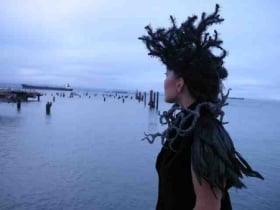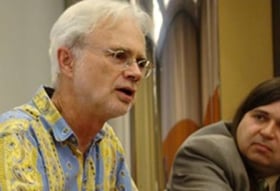YouTube Your Way to Pianistic Fame
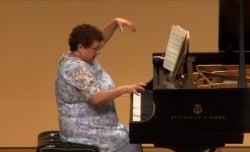
Beginning Sept. 1 (vacation day for Music News and Classical Voice), the Van Cliburn Foundation will host its second "Cliburn YouTube Contest for Amateur Pianists." Applicants can submit a 5-to-10-minute performance video recorded within the past six months to be judged by online viewers.
The winner of the contest will receive automatic entry into the sixth International Piano Competition for Outstanding Amateurs, scheduled for May 23-29, 2011. The application fee will be waived.
If you are not familiar with the Amateurs' Competition, take a look at the fascinating and heartwarming documentary They Came to Play.
Definition of "amateur" for this purpose: any classical pianist who does not derive a significant portion of his or her income from performance, composition, and/or piano instruction and is at least 35 years old. (Excluding piano teachers doesn't seem fair, but that's the way it is.) The winner may not have won any previous Cliburn competitions.
Video entries will be accepted through Nov. 2, and posted on the Van Cliburn Foundation's YouTube Channel. Beginning Nov. 9, voters may go online and select the contestant of their choice. Voters will be required to register through the Cliburn Web site, and will be sent a ballot via e-mail. Voting closes on Nov. 24.
Speaking of Competitions...
There is a "dark side" to piano competitions, says an Op Ed piece in the New York Times, quoting Bartók that "competitions should be for horses, not musicians." The composer refused to sit on juries because he "didn’t want the decisions on his conscience."
Michael Johnson's article says there are now 750 competitions in existence, of which about 350 were staged last year alone, and "behind the black ties, strapless gowns and Oscar-like atmosphere of the finals lurks a world of naked ambition, sometimes corrupt judging and bitter disputes over the results."
Those who share that view are circulating a petition calling for "transparency in international music competitions," beginning with disclosure of votes. Seems a reasonable request; here's the address to sign the petition, and a list of signatories, including some well-known names.
The Two Baritones of Odessa
Baritones — the men usually low on the totem pole of operatic glitter — came decisively to the fore Saturday night in the Opera House at the Merola Program's Grand Finale.
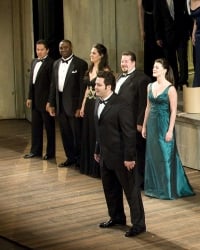
Born in Odessa, raised in San Francisco (where he played the guitar in high school, rather than sing), Aleksey Bogdanov showed off a warm, appealing, sensitive, intelligent baritone, startlingly mature for somebody in his mid-20s, in a knock-'em-dead performance of the Prologue from Leoncavallo's Pagliacci.
Exactly the same adjectives applied to another Odessa-born baritone, Michael Sumuel, whose Alidoro from Rossini's La Cenerentola was a triumph. Sumuel's Odessa is in Texas, not Ukraine, and he may be a bit older than Bogdanov, but still a baby in the Kavalierbariton fach where life begins at 40. To make the event even more remarkable, both baritones excelled in diction, projection, stage presence.
Every year, the concert concluding the Merola Program is an important event: it puts young singing stars of the next generation before a large audience, ends the summer doldrums, and serves as a warm-up act of the opening of the season, just around the corner (Sept. 11).
This year, there was something extra: a thoroughly, delightfully enjoyable evening of opera with consistently excellent performances, some mind-bogglingly so, and the Opera Orchestra, under the direction of Antony Walker playing sensationally at this, their first appearance after the summer break. The evening-closing Falstaff finale could have made any opera house in the world proud. And there they were, the two Odessa baritones, side by side, Bogdanov as Falstaff and Sumuel as Ford.
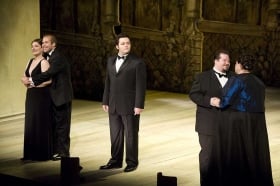
The entire vocal range was well represented, from countertenor Ryan Belongie with a gorgeous aria from Handel's Xerxes, to tenor Eleazar Rodriguez's performance of Belmonte's aria ("Ich baue ganz") from The Abduction of the Seraglio, to yet another talented baritone, Yohan Yi, singing Aleko's aria from the Rachmaninov opera, with deep feeling and impeccable Russian.
During the Merola season, soprano Susannah Biller and mezzo Maya Lahyani distinguished themselves, but on Saturday they both reached new heights: Biller's Zdenka (with Lori Guilbeau's Arabella), and Héro (from Béatrice [Lahyani] et Bénédict [Suzanne Hendrix as Ursule]), showed a young artist ready for the big time. Lahyani's Carmen (with Brian Jagde's Don José) was both vocally and theatrically seductive.
Programming for the evening was excellent, with some lesser-known selections preempting the customary warhorses. In addition to Aleko, the Berlioz, and Suzanne Hendrix's affecting performance of Cornelia's aria from Giulio Cesare, there was a duet from Thomas' Mignon (with Ellie Jarrett and Evan Boyer) and Lothario's aria (with Boyer), and Margaret Gawrysiak sang Joan's aria from Tchaikovsky's Joan of Arc.
I am afraid without YouTube or an MP3, I cannot do justice to that closing "Tutto nel mondo e burla." It was all there, and all good. Take this as a poor substitute.
Michael Morgan Anniversary Concert
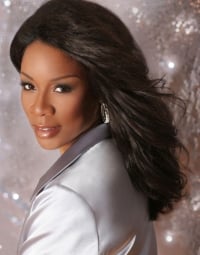
"An Evening With Denyce Graves" will celebrate Michael Morgan's 20th anniversary as music director of the Oakland East Bay Symphony in the Fox Theater on Oct. 3. The event with the acclaimed mezzo is a benefit for the orchestra's youth education programs, which serve 24,000 Bay Area students annually.
Graves, who will sing from operas and Broadway productions, has been heard in San Francisco in the title role of Carmen and as Baba the Turk in The Rake's Progress.
Tickets for the gala concert, dinner, and reception are priced from $60 to $250, available from Ticketmaster.com.
Mary Morris Lawrence
The first recognized female news photographer, who has also taken hundreds of famous photos of musicians, Mary Morris Lawrence, died on Aug. 12 at age 95.

She and her husband, London Symphony Orchestra General Manager Harold Lawrence, moved to Oakland in 1978, after he was named president and general manager of the Oakland Symphony. The couple had an important role in the Bay Area's musical life for two decades. He appointed Calvin Simmons music director of the Symphony, and her photos of the young African-American conductor were published around the world.
"I loved her for how brave she was," her husband said. That bravery included overcoming a brain tumor in 1964 that involved seven operations. "But she continued her career and went bravely on."
A service celebrating her life will be held on Aug. 29 in Oakland's Chapel of the Chimes. Read Angela Woodall's obituary of Mary Morris Lawrence in the Oakland Tribune.
Urban Opera's Dido and Aeneas
Urban Opera's inaugural production — Henry Purcell's Dido and Aeneas — was offered last weekend, and Classical Voice's Lisa Hirsch was there, risking frostbite on a typical San Francisco evening, a la Mark Twain:
It was a most unusual San Francisco location: the outdoor plaza poised between 409 and 499 Illinois St. The company made fine use of the open space, locating the audience and the tiny Jubilate Baroque Orchestra with their backs to one of the buildings. San Francisco Bay, clouds, gulls, ships, and waving bamboo made a dramatic backdrop for Purcell's great miniature, and the singers, their voices resounding off the walls, were readily audible.The performances started at 7 p.m. and ended around 8:15, early enough that the members of the orchestra didn't need lights to see their music. Reports of the Friday performance say the temperature stayed reasonably warm nearly to the end, but by 7:30 on Saturday, I wished I'd worn an extra layer or two. The lightly-costumed singers must have been freezing by the end of the performance, except, of course, that they got to move around.
And move around they did, making entrances and exits from behind the audience and from the farthest reaches of the plaza. Some scenes were played immediately in front of the audience, some at more of a distance, such as the royal hunt. The chorus made an especially striking entry during Act I, scene 2, as witches hidden under huge swathes of black gauze that blew about in the wind as the singers ran toward the audience from the far edge of the plaza. The exiled Trojans made an impressive and regimented entrance from the same starting point. The staging throughout was direct and effective. Kue King designed the beautiful costumes.
The vocal stars of the show were Kindra Scharich as Dido, Queen of Carthage, and Kimarie Torre as Belinda, her sister. Both sang with pure tone and fine control, Scharich neatly and movingly projecting the Queen's tragedy. Pam Igelsrud was a sprightly Second Woman. Milissa Carey put on quite a show as the Sorceress, though it was hard to tell whether her glottal attacks were intended as camp.
Cortez Mitchell and Michael McNeil made a striking pair of witches, visually and vocally. Todd Wedge was fine as Aeneas. The orchestra played crisply and with rhythmic verve under the direction of E. E. "Chip" Grant IV, the company's artistic director and conductor.
Programming Polemics, Part II
In last week's Music News, Michael Tilson Thomas replied to my question about how he balances programming for the San Francisco Symphony. While his record has been stellar in many respects, one aspect of the equation -- playing the music of respected local composers -- can be, and probably will continue to be challenged.
Robert Commanday, a prominent music-critic advocate for "the locals," responds to MTT's statement by saying the music director "keeps unblemished his record of ignoring composers resident in the Bay Area.
Considerably more than 30 living composers of merit have been passed over by the Symphony during MTT's 14 seasons here. Prominent among them is Wayne Peterson whose The Face of the Night, the Heart of the Dark, as performed by the San Francisco Symphony in 1992 under Herbert Blomstedt, won the Pulitzer Prize that year.Of the deceased composers ignored, several rank high in the pantheon of American musical life: Darius Milhaud, Roger Sessions, Andrew Imbrie and Ernest Bloch. All of these composers, living and dead, have contributed immeasurably to the Bay Area's classical musical life, one that ranks second only to New York's in the richness and vitality of its activity. Yet they are not even considered for performance by its principal orchestra. If the San Francisco Symphony does not perform them, who should? Why should accomplished composers continue to live here?
Previous music directors of the San Francisco Symphony, Josef Krips and Edo de Waart in particular, gave generously committed performances to distinguished compositions by our resident composers. Under the executive directorship of Peter Pastreich, the Symphony formerly engaged composers, including John Adams, Charles Wuorinen and the late George Perle, as musical advisors to guide this activity.
Unaccountably for a conductor who has been lauded for adventuresome programming, Thomas has retreated from the music of his generation as well as from the music created in this region. The only Bay Area composers Thomas has performed during his tenure have been John Adams, the late Lou Harrison, the late John Thow (one composition) and himself.
[Ed. Note: Electronica and classical composer Mason Bates had his The B-Sides performed by the Symphony just last spring, to great acclaim.]
Here are a few of the composers from the region — dead or alive — who I would nominate to be on an SFS program in the future; please use the Comments field below the column to add your nominations.
Mark Alburger, Mark Applebaum, Elinor Armer, Ross Bauer, Dan Becker, Christian Baldini, Jonathan Berger, Herb Bielawa, Lisa Bielawa, Ann Callaway, Ronald Caltabiano, Edmund Campion, David Conte, Cindy Cox, Nancy Bloomer Deussen, Tamar Diesendruck, Lori Dobbins, Edwin Dugger, Richard Felciano, Brian Ferneyhough, Richard Festinger, Gabriela Frank, David Garner, Jake Heggie, Melissa Hui, Andrew Imbrie (deceased), Deniz Ince, Jaroslaw Kapuscinski, Hi Kyung Kim, Frank La Rocca, Jorge Liderman (deceased), Kirke Mechem, Darius Milhaud (deceased), Jeffrey Miller, Eric Moe, Roger Nixon, Pablo Ortiz, Wayne Peterson, Kurt Rohde, Martin Rokeach, Laurence Rosenthal, Jonathan Russell, Laurie San Martin, Roger Sessions (deceased), Allen Shearer, Conrad Susa, David Sheinfeld (deceased), John Thow (deceased), Ken Ueno, Olly Wilson, Mark Winges.
The California Symphony Alternative
A former member of the San Francisco Symphony, Barry Jekowsky, founded the California Symphony of Walnut Creek in 1986. Since 1991, the orchestra presented 31 world premieres. On a $1.6 million budget (vs. the SF Symphony's $63.5 million), California Symphony has performed at least one work by an American composer on every single subscription program.
In just one season (of only four pairs of concerts), California Symphony offered five world premieres and nine works by American composers while SFS's scores of programs included six American compositions.
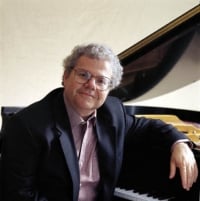
Jekowsky also established the Young American Composer-in-Residence Program in 1991. It supports development of new American classical works through residencies for emerging young composers. BMI has awarded a special citation to Jekowsky and CSO "for their passionate commitment to young American composers. We know of no other orchestra anywhere in the world doing this type of groundbreaking work with young composers."
But, as MTT pointed out in last week's Music Notes, SFS is observing its approaching 100th anniversary (in 2011) with the Centennial Initiatives Program that aims at expanding commissioning activities.
The 2009-2010 season in San Francisco offers six world premieres: an SFS-commissioned work by Victor Kissine, pianist Emanuel Ax performing premieres of three SFS co-commissions written specifically for him by Peter Lieberson, Osvaldo Golijov, and John Adams. Edwin Outwater will conduct the world premiere of Rufus Wainwright’s commissioned Five Shakespeare Sonnets, and Christoph Eschenbach will lead the premiere of a commissioned work by Austrian composer Thomas Larcher. Also scheduled: the U.S. premiere of Detlev Glanert's Shoreless River ("Fluss ohne Ufer"), co-commissioned by SFS and conducted by Semyon Bychkov in November.
Where Alsop Gets Her Mojo
"The Music Man has Marion the Librarian, but what about the Music Woman, Marin Alsop?," writes Chris Watson. "As it happens, the music director of the Cabrillo Festival of Contemporary Music has a librarian, too."
She is Ella Fredrickson, full-time performance librarian for The Florida Orchestra in Tampa, and Alsop's personal collection librarian since 1990. She began freelancing as the librarian for Cabrillo in 2002.
What does a music librarian do? Read her story in the Santa Cruz Sentinel.
Do We Face 'Digital Apocalypse'?
"The digital apocalypse continues to blight the lives of television producers, music-industry executives and newspaper publishers, all of whom are scrambling to figure out how to reconfigure their business models in such a way as to allow them to make an honest buck. They're trying to second-guess the future — so why not look back at the past?," asks Terry Teachout in a Wall Street Journal article.
Looking back to 1949, there was another "technological change has laid waste to the best-laid plans of the old media." Network radio ruled (with 85 million sets in the country) and TV had a paltry 1.3 million sets (the 16-inch model costing $695 back then — half the price of a new car), and all TV stations and networks operating in the red. Sounds a bit like today's newspapers and download-robbed music producers.
But then came long-distance coaxial cable, live network programming, and the new media took over the world, even while the old (radio, newspapers, vinyl records, etc.) survived. Maybe, just maybe, not the whole sky is falling now... although it sure looks that way, especially because of a new numbers paradigm.
In those "good old times," there was always a mechanism of constraint; radios needed spectrum so you could only fit perhaps 20 AM radio stations without interference, and initially TV had 13 channels (remember the rotary dials?).
Now, with unlimited Web sites and slowly growing connectivity, it is possible to access 10,000 radio stations or 100 million Web sites and this profusion of variety is working against any centralized control. Centralization is needed to aggregate customers. If there are effectively 100,000 newspapers available now, will each one have only 100 readers? Without a broad subscriber base, there is no income and won't be either, regardless of the inevitable development of technology.

